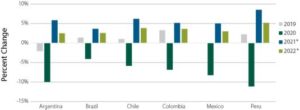The recent protests in Cuba have caught the attention of people worldwide. However, the mainstream media seldom addresses some of the most significant drivers behind protests like these.
Socialism and communism dominated countries like Cuba have long suffered economically, due to the anti-capitalistic nature of economy.
Some of the countries in South America could become the next Cuba if they do not make significant changes to their economic policies.
Mexico, Ecuador, and Peru elected new leaders this year. More countries in South America will undertake national elections in 2021 and the people there have a chance to choose the right way forward.
They must choose pro-capitalist leaders if they aspire to progress as a nation and individuals, and put behind the plagues of socialism, communism and dictatorship.
Rising Food Prices Demand Immediate Economic Reforms
Around 80 million people in six Latin American countries are at the risk of falling below the poverty line. The pandemic in 2020 and 2021 has further worsened the situation in South America. Latin American constituted some of the top countries with the highest Covid-19 death rates in the world.
Inflation is rampant in many South American countries like Colombia, Mexico, Brazil, Argentina, and Chile. Between March 2020 and March 2021 food prices rose by 56% in Argentina. Brazil recorded a 17% increase in food prices and Colombia registered a 12% increase.
South America: In Dire need of Free-Market and Capitalism
The countries in the continent are in dire need of foreign investments and only a free-trade economy can support the influx of funds.
An assessment of the economy in South American countries reveals a stark contrast between capitalistic and socialistic states.
For example, Chile benefited immensely from their free-trade economy in the last one decade, while Venezuela dived deep into the pits of poverty due to authoritarianism and socialism.
In fact, while the rest of the continent faced a surge in food prices during the past one year, Chile managed to keep the increase in prices to just 5.8%, thanks to an economy that is growing fast.

Gross Government Debt to GDP
Source: IMF, World Economic Outlook database. Data as of 4/30/2021
Among the leading economies in South America, Peru and Chile have the lowest Debt to GDP ratio, indicating a strong economy in those two countries.
Peru’s economy was able to achieve this because of the “considerable free market reforms that legalized the informal sector and brought in significant privatization in the mining, electricity, and telecommunications industries.” Poverty rate in Peru reduced from 60% in 2004 to just 20% in 2016.
Peru also benefited from the sales of produce from its large petroleum and natural gas reserves in the Cusco and Madre de Dios regions. Other countries in South America–if they really aspire to improve GDP and reduce poverty–must not abandon their natural resources in the name of climate change.



Source: IMF, World Economic Outlook database. Data as of 4/30/2021. GDP growth figures for 2021 and 2022 are projections
According to the International Monetary Fund, Peru and Chile are forecasted to register the highest growth in GDP in the post-pandemic years.
This is a testament to their capitalist economies and their willingness to let go of the dominant communist and socialist economic philosophies in the continent.
Brazil, Mexico, and Argentina are all in an ideal position to make a transition to a capitalistic economy and they must not wait for things to get worse.
The situation in Venezuela and Cuba are a reminder to stay clear of socialism and communism, not just to South America but to other countries globally.
* This article was originally published here
HELP STOP THE SPREAD OF FAKE NEWS!
SHARE our articles and like our Facebook page and follow us on Twitter!








0 Comments